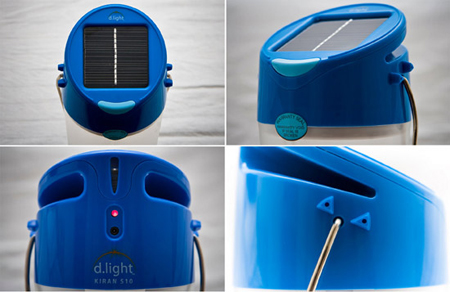
D.light is one of a number of Silicon Valley startups determined to mix money-making with having a positive social impact. It believes there are viable markets to be tapped in the poorest parts of the world, and its investors, including Draper Fisher Jurvetson, the Acumen Fund and Nexus Venture Partners, seem to agree.
[aditude-amp id="flyingcarpet" targeting='{"env":"staging","page_type":"article","post_id":192570,"post_type":"story","post_chan":"none","tags":null,"ai":false,"category":"none","all_categories":"business,enterprise,","session":"C"}']The number of homes in Africa and India with no access to power grids is staggering, not to mention small businesses, schools and other public buildings that would benefit greatly from keeping the lights on after dark. D.light offers three different models of lights.
Its Nova model resembles a floodlight, emitting a cool, white light than can run for 12 hours after absorbing sunlight for an entire day. It can also be used to charge cell phones — an increasingly important double-feature as more residents of the developing world rely on mobile phones for internet access — in as little as two hours. D.light says it is about 10 times brighter than an average kerosene lantern and almost 50 percent more energy efficient than fluorescent lights.
AI Weekly
The must-read newsletter for AI and Big Data industry written by Khari Johnson, Kyle Wiggers, and Seth Colaner.
Included with VentureBeat Insider and VentureBeat VIP memberships.
Its Kiran model (pictured above), which looks a lot like something Apple might make, shines for 8 hours on a full charge and is four times brighter than kerosene. A single unit, with no detachable parts, it casts off 360 degrees of light to illuminate whole rooms for cooking, and after-school homework. It could make a major impact on the lives of children and women, who might otherwise be restricted to cooking or housework during daylight hours, giving them less time for school or other, potentially empowering, employment.
One of D.light’s case studies is of a 14-year old girl named Monika Singh, who was able to use a D.light lantern to study longer each day. It replaced a kerosene lamp that would continually blow out or fill her house with smoke. The quality of the light (cool, bright, and unflickering) also helped her finish her homework faster, Singh said.
Lastly, its Solata model — an average-looking desk lamp — provides 15 hours of light on a full charge and is five to six times brighter than kerosene. Like the Nova, it comes with a portable, detachable solar panel.
All three products are manufactured fairly cheaply, and sold for more than $10 but generally less than $20. This sounds like a hefty price tag for regions where the average daily income is significantly below $10, but that’s built into D.light’s business model. It wants its lamps to be a significant household purchase. Considering that households in its target regions spend up to 30 percent of their monthly incomes on kerosene, this seems justified.
That said, the company has been making a major push to lower its own costs — allowing it to continually drop prices. After starting up in Silicon Valley, it moved operations to New Delhi, India. And is now based in Hong Kong, where it can build relationships with and oversee even lower-cost manufacturing facilities. In 2008, when the company initially raised $6 million, its high-end products ranged up to $30, so prices have clearly come down.
That original $6 million came from the investors named above, in addition to Garage Technology Ventures, Mahindra Group, and Gray Matters Capital. The fact that D.light has been able to secure another round of funding is indicative of a trend toward more venture interest in social impact enterprises — especially from firms like Acumen and Gray Matters, which specialize in the field. Doing good may no longer mean that a company can’t do well. It’s a concept that’s catching on.
[aditude-amp id="medium1" targeting='{"env":"staging","page_type":"article","post_id":192570,"post_type":"story","post_chan":"none","tags":null,"ai":false,"category":"none","all_categories":"business,enterprise,","session":"C"}']
VentureBeat's mission is to be a digital town square for technical decision-makers to gain knowledge about transformative enterprise technology and transact. Learn More
